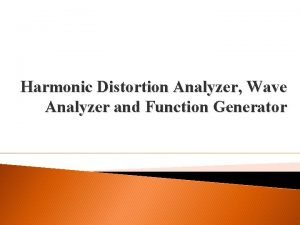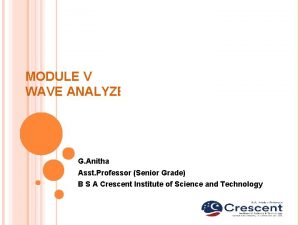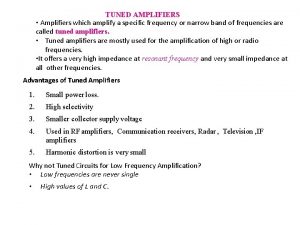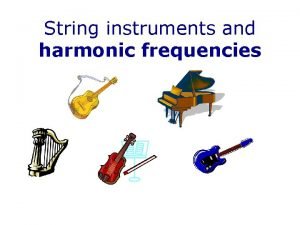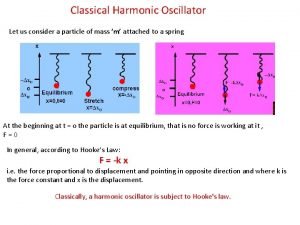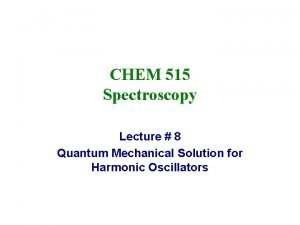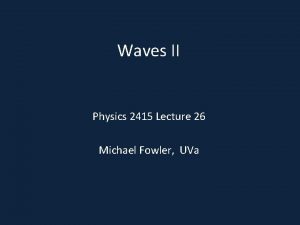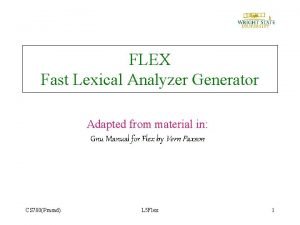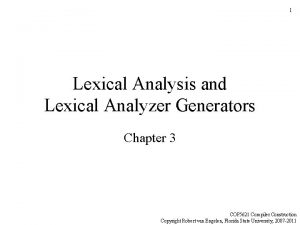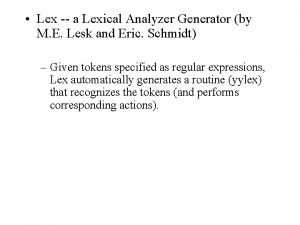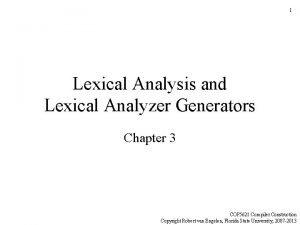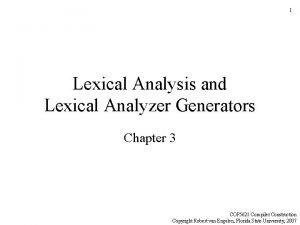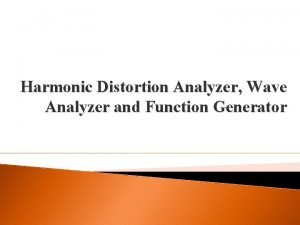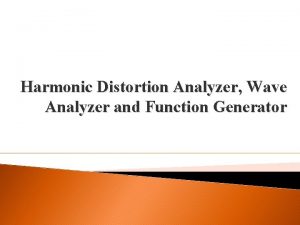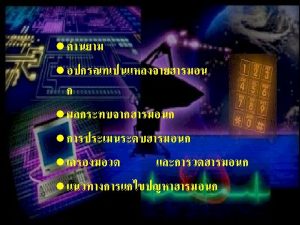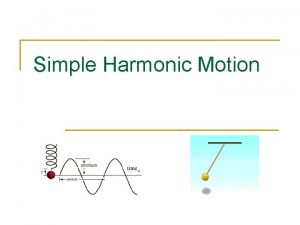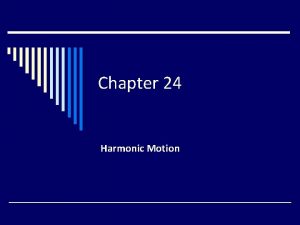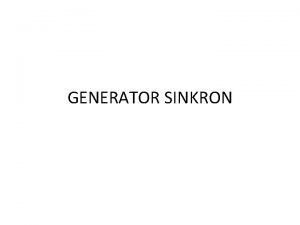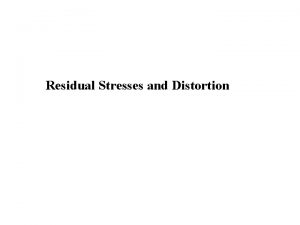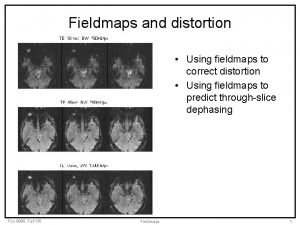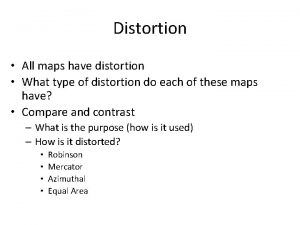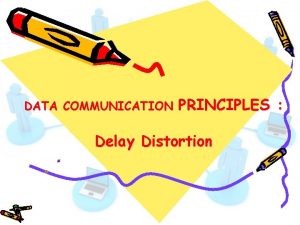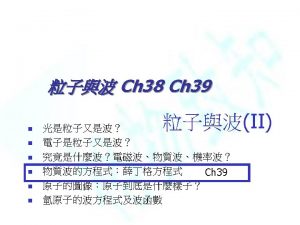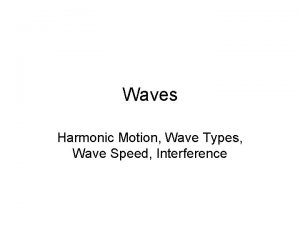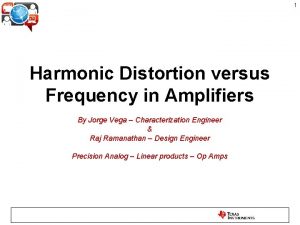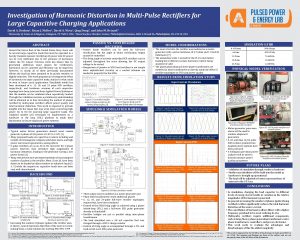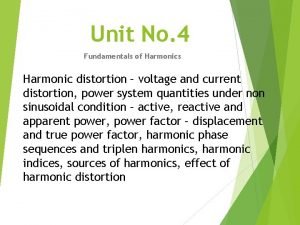Harmonic Distortion Analyzer Wave Analyzer and Function Generator
















- Slides: 16

Harmonic Distortion Analyzer, Wave Analyzer and Function Generator

Distortion Analyzer � Distortion – the alteration of the original shape of a waveform. � Function of distortion analyzer: measuring the extent of distortion (the o/p differs from the waveform at the i/p) introduced by the active or passive devices. An amplitude distorted sine wave is made up of pure sine wave components, including the fundamental frequency, f of the input signal, and harmonic multiples of fundamental frequency, 2 f, 3 f, 4 f, etc. � � � Harmonic distortion can be measured accurately using harmonic distortion analyzer, generally called a distortion analyzer. The total harmonic distortion (THD) is given by :

The total harmonic distortion (THD) can also be written as :


Wave Analyzer � � A harmonic distortion analyzer measures the total harmonic content in a waveform. Any complex waveform is made up of a fundamental and its harmonics. Wave analyzer is used to measure the amplitude of each harmonic or fundamental frequency individually. Wave analyzers are also referred to as frequency selective voltmeters, carrier frequency voltmeters, and selective level voltmeters. � The instrument is tuned to the frequency of one component whose amplitude is measured. � Some wave analyzers have the automatic frequency control which tunes to the signal automatically.

� Wave Analyzer

Working process for wave analyzer � The analyzer consists of a primary detector, which is a simple LC circuit. � The LC circuit is adjusted for resonance at the frequency of the particular harmonic component to be measured. � It passes only the frequency to which it is tuned and provides a high attenuation to all other frequencies. � The full wave rectifier is used to get the average value of the input signal. � The indicating device is a simple dc voltmeter that is calibrated to read the peak value of the sinusoidal input voltage.

Introduction to the Function Generator

Function Generator

What is a function generator? �A function generator is a device that can produce various patterns of voltage at a variety of frequencies and amplitudes. � It is used to test the response of circuits to common input signals. The electrical leads from the device are attached to the ground and signal input terminals of the device under test.

Features and controls � Most function generators allow the user to choose the shape of the output from a small number of options. � -Square wave - The signal goes directly from high to low voltage. -Sine wave - The signal curves like a sinusoid from high to low voltage. -Triangle wave - The signal goes from high to low voltage at a fixed rate � The amplitude control on a function generator varies the voltage difference between the high and low voltage of the output signal. � The direct current (DC) offset control on a function generator varies the average voltage of a signal relative to the ground.

Continue. . � The frequency control of a function generator controls the rate at which output signal oscillates. On some function generators, the frequency control is a combination of different controls. � One set of controls chooses the broad frequency range (order of magnitude) and the other selects the precise frequency. This allows the function generator to handle the enormous variation in frequency scale needed for signals.

Block diagram of a function generator

Output waveform � Freq. Control – regulates two currents sources (control the freq). � Upper current source – supplies constant current to the integrator, produces an output voltage that is increasing linearly with time. � Lower current source – supplies a reverse current to the integrator so that its output decreases linearly with time.

• The integrator output voltage is given by : • Frequency is controlled by varying upper and lower currents. • An increase or decrease in the current will increase or decrease the slope of the output voltage, hence controls the frequency. • The voltage comparator – changes states at a pre-determined maximum and minimum level of the integrator output voltage. • When the pre-determined level is reached, it changes the state and switches the current source. • Produces a square wave.

� The integrator output is a triangular waveform whose frequency is determined by the magnitude of the constant current sources. � The comparator output delivers a square wave of the same frequency. � The resistance diode network produces a sine wave from the triangular wave with less than 1% distortion.
 Harmonic distortion analyzer ppt
Harmonic distortion analyzer ppt Fundamental suppression harmonic distortion analyzer
Fundamental suppression harmonic distortion analyzer Advantages of tuned amplifier
Advantages of tuned amplifier Tension wave
Tension wave Classical harmonic oscillator
Classical harmonic oscillator Wave function of quantum harmonic oscillator
Wave function of quantum harmonic oscillator Standing wave equation
Standing wave equation What is a harmonic wave in physics
What is a harmonic wave in physics Famous generators human design
Famous generators human design Flex unix
Flex unix Lexical analysis generator
Lexical analysis generator Lexical analyzer generator lex
Lexical analyzer generator lex Flex lexical analyser
Flex lexical analyser Design of lexical analyzer generator
Design of lexical analyzer generator Design of lexical analyzer generator
Design of lexical analyzer generator Heterodyne wave analyzer
Heterodyne wave analyzer Difference between full wave and half wave rectifier
Difference between full wave and half wave rectifier
